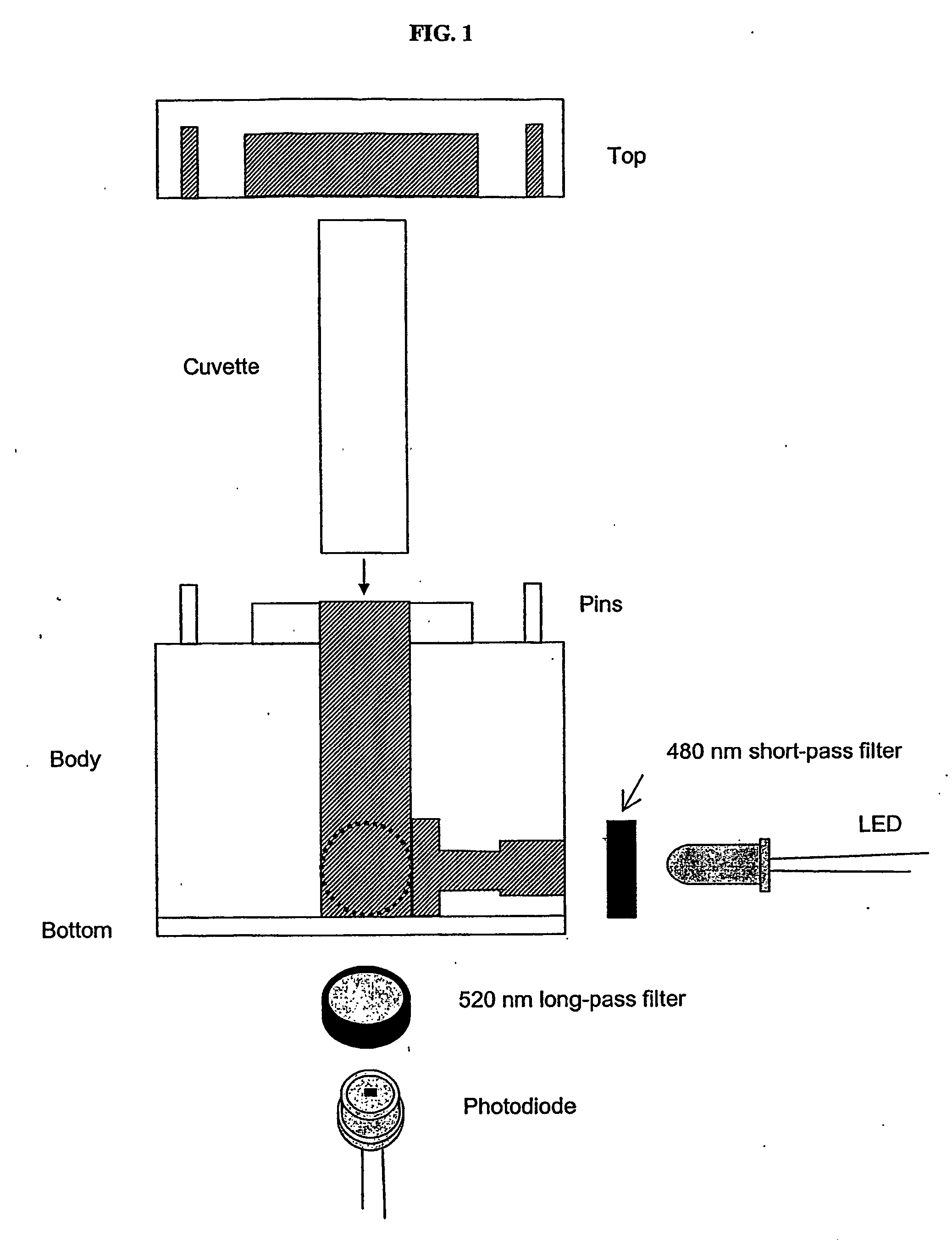Detection of somatic cells in milk
a somatic cell and milk technology, applied in the field of milk somatic cell detection, can solve the problems of milk in transport risk degradation and contamination, time and effort wasted in collecting and shipping samples, and the single most costly disease of the dairy industry is mastitis, so as to achieve the effects of low cost, high cost, and high efficiency
- Summary
- Abstract
- Description
- Claims
- Application Information
AI Technical Summary
Benefits of technology
Problems solved by technology
Method used
Image
Examples
example 1
Assay Development
[0065] Three extraction procedures examples are provided. Method one included a fat removal step via centrifugation and the use of a commercial DNA extraction kit (DNeasy Tissue Kit, Cat. No. 69504, Qiagen, Valencia, Calif., USA). The DNA extraction method was performed as follows: Two milliliters of milk was centrifuged for 10 minutes at 5000 g. The fat and aqueous layer were removed. The pellet was resuspended in 200 μL of phosphate buffered saline. The steps for DNeasy Protocol for Cultured Animal Cells in the DNeasy Tissue Kit Handbook were then followed. In a cuvette, all of the final DNA solution (˜200 μL), 787 μL of 10 mM Tris, 1 mM EDTA, pH 7.5 (TE) and 13 μL of PicoGreen stock reagent were added. The cuvette was inverted to mix the solution and then inserted into the sensor and record the output voltage. Calibration with method one was the most sensitive to changes in SCC because the assay produced a purer form of DNA. The calibration equation based on met...
example 2
Sensor and Circuit Design
[0070] The sensor housing consisted of four pieces: the top, bottom, and two sides (FIG. 1). Side one contained a 470 nm light-emitting diode (LED) (BL-BBX3V4V-B02, American Bright, San Jose, Calif., USA) and a 480 nm short-pass edge filter (35-2039, Ealing Catalog, Inc., Rocklin, Calif., USA). Side two held a photodiode (BPW21R, Vishay, San Jose, Calif., USA) and a 520 nm long-pass edge filter (35-2153, Ealing Catalog, Inc., Rocklin, Calif., USA). The LED and photodiode were positioned perpendicular to each other. Sides one and two and the bottom piece were screwed together to form a block, which served as the main unit to hold a 1.5 mL sample cuvette (14-385-942, Fisherbrand, Fisher Scientific). The top piece completed the housing and was secured to the unit with pins.
[0071] The circuit consisted of three stages: a photovoltaic amplifier, a low-pass filter, and a final gain stage using an inverting amplifier (FIG. 2). An optical filter that passed wavele...
example 3
Calibration
[0072] The sensor was calibrated with known concentrations of ctDNA in TE. Concentrations were prepared by diluting 500 ug / mL of ctDNA with TE to a final volume of 987 μL in a cuvette. The final solution was mixed with 13 μL of PicoGreen stock reagent by inversion. PicoGreen was given one minute to bind to ctDNA before the cuvette was inserted into the sensor for a reading. dsDNA was tested at concentrations between 0 to 6 μg / mL, which roughly corresponded to SCCs in the range of 0 to 1,000,000 cells / mL. Two replicates were completed at each concentration.
[0073] Preliminary calibrations were also completed with extracted DNA from raw milk with known SCCs using methods one, two, and three. Cows with low, medium and high levels of SCC were chosen based on monthly DHI reports. Based on the National Mastitis Council guidelines and federal and state regulations, SCCs less than or equal to 200,000 cells / mL were considered to be low, SCCs greater than 200,000, but less than or...
PUM
| Property | Measurement | Unit |
|---|---|---|
| wavelength | aaaaa | aaaaa |
| cutoff frequency | aaaaa | aaaaa |
| pH | aaaaa | aaaaa |
Abstract
Description
Claims
Application Information
 Login to View More
Login to View More - R&D
- Intellectual Property
- Life Sciences
- Materials
- Tech Scout
- Unparalleled Data Quality
- Higher Quality Content
- 60% Fewer Hallucinations
Browse by: Latest US Patents, China's latest patents, Technical Efficacy Thesaurus, Application Domain, Technology Topic, Popular Technical Reports.
© 2025 PatSnap. All rights reserved.Legal|Privacy policy|Modern Slavery Act Transparency Statement|Sitemap|About US| Contact US: help@patsnap.com



